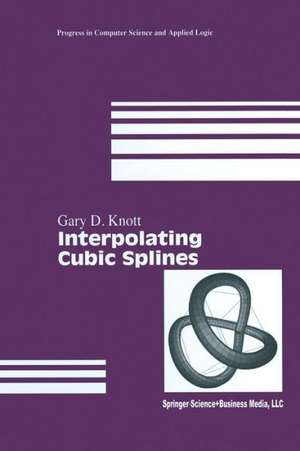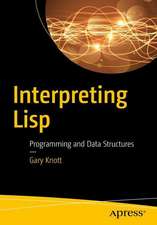Interpolating Cubic Splines: Progress in Computer Science and Applied Logic, cartea 18
Autor Gary D. Knotten Limba Engleză Paperback – 15 oct 2012
Din seria Progress in Computer Science and Applied Logic
- 20%
 Preț: 342.78 lei
Preț: 342.78 lei -
 Preț: 380.25 lei
Preț: 380.25 lei - 20%
 Preț: 333.54 lei
Preț: 333.54 lei - 20%
 Preț: 1020.33 lei
Preț: 1020.33 lei - 15%
 Preț: 591.29 lei
Preț: 591.29 lei - 20%
 Preț: 340.49 lei
Preț: 340.49 lei - 20%
 Preț: 611.79 lei
Preț: 611.79 lei - 20%
 Preț: 334.71 lei
Preț: 334.71 lei - 20%
 Preț: 655.85 lei
Preț: 655.85 lei -
 Preț: 387.75 lei
Preț: 387.75 lei - 15%
 Preț: 588.04 lei
Preț: 588.04 lei - 20%
 Preț: 474.87 lei
Preț: 474.87 lei -
 Preț: 410.88 lei
Preț: 410.88 lei -
 Preț: 393.74 lei
Preț: 393.74 lei -
 Preț: 403.75 lei
Preț: 403.75 lei - 15%
 Preț: 646.75 lei
Preț: 646.75 lei - 15%
 Preț: 646.43 lei
Preț: 646.43 lei - 20%
 Preț: 646.80 lei
Preț: 646.80 lei - 20%
 Preț: 339.66 lei
Preț: 339.66 lei - 15%
 Preț: 698.94 lei
Preț: 698.94 lei - 15%
 Preț: 653.79 lei
Preț: 653.79 lei - 18%
 Preț: 730.79 lei
Preț: 730.79 lei -
 Preț: 399.29 lei
Preț: 399.29 lei - 20%
 Preț: 420.91 lei
Preț: 420.91 lei - 20%
 Preț: 335.03 lei
Preț: 335.03 lei -
 Preț: 379.86 lei
Preț: 379.86 lei -
 Preț: 381.00 lei
Preț: 381.00 lei - 20%
 Preț: 334.86 lei
Preț: 334.86 lei
Preț: 586.71 lei
Preț vechi: 733.38 lei
-20% Nou
Puncte Express: 880
Preț estimativ în valută:
112.27€ • 117.76$ • 93.46£
112.27€ • 117.76$ • 93.46£
Carte tipărită la comandă
Livrare economică 01-15 aprilie
Preluare comenzi: 021 569.72.76
Specificații
ISBN-13: 9781461270928
ISBN-10: 1461270928
Pagini: 260
Ilustrații: XII, 244 p.
Dimensiuni: 155 x 235 x 14 mm
Greutate: 0.37 kg
Ediția:Softcover reprint of the original 1st ed. 2000
Editura: Birkhäuser Boston
Colecția Birkhäuser
Seria Progress in Computer Science and Applied Logic
Locul publicării:Boston, MA, United States
ISBN-10: 1461270928
Pagini: 260
Ilustrații: XII, 244 p.
Dimensiuni: 155 x 235 x 14 mm
Greutate: 0.37 kg
Ediția:Softcover reprint of the original 1st ed. 2000
Editura: Birkhäuser Boston
Colecția Birkhäuser
Seria Progress in Computer Science and Applied Logic
Locul publicării:Boston, MA, United States
Public țintă
ResearchCuprins
1 Mathematical Preliminaries.- 1.1 The Pythagorean Theorem.- 1.2 Vectors.- 1.3 Subspaces and Linear Independence.- 1.4 Vector Space Bases.- 1.5 Euclidean Length.- 1.6 The Euclidean Inner Product.- 1.7 Projection onto a Line.- 1.8 Planes in-Space.- 1.9 Coordinate System Orientation.- 1.10 The Cross Product.- 2 Curves.- 2.1 The Tangent Curve.- 2.2 Curve Parameterization.- 2.3 The Normal Curve.- 2.4 Envelope Curves.- 2.5 Arc Length Parameterization.- 2.6 Curvature.- 2.7 The Frenet Equations.- 2.8 Involutes and Evolutes.- 2.9 Helices.- 2.10 Signed Curvature.- 2.11 Inflection Points.- 3 Surfaces.- 3.1 The Gradient of a Function.- 3.2 The Tangent Space and Normal Vector.- 3.3 Derivatives.- 4 Function and Space Curve Interpolation.- 5 2D-Function Interpolation.- 5.1 Lagrange Interpolating Polynomials.- 5.2 Whittaker’s Interpolation Formula.- 5.3 Cubic Splines for 2D-Function Interpolation.- 5.4 Estimating Slopes.- 5.5 Monotone 2D Cubic Spline Functions.- 5.6 Error in 2D Cubic Spline Interpolation Functions.- 6 ?-Spline Curves With Range Dimension d.- 7 Cubic Polynomial Space Curve Splines.- 7.1 Choosing the Segment Parameter Limits.- 7.2 Estimating Tangent Vectors.- 7.3 Bézier Polynomials.- 8 Double Tangent Cubic Splines.- 8.1 Kochanek-Bartels Tangents.- 8.2 Fletcher-McAllister Tangent Magnitudes.- 9 Global Cubic Space Curve Splines.- 9.1 Second Derivatives of Global Cubic Splines.- 9.2 Third Derivatives of Global Cubic Splines.- 9.3 A Variational Characterization of Natural Splines.- 9.4 Weighted v-Splines.- 10 Smoothing Splines.- 10.1 Computing an Optimal Smoothing Spline.- 10.2 Computing the Smoothing Parameter.- 10.3 Best Fit Smoothing Cubic Splines.- 10.4 Monotone Smoothing Splines.- 11 Geometrically Continuous Cubic Splines.- 11.1 Beta Splines.- 12 Quadratic SpaceCurve Based Cubic Splines.- 13 Cubic Spline Vector Space Basis Functions.- 13.1 Bases for C1 and C2 Space Curve Cubic Splines.- 13.2 Cardinal Bases for Cubic Spline Vector Spaces.- 13.3 The B-Spline Basis for Global Cubic Splines.- 14 Rational Cubic Splines.- 15 Two Spline Programs.- 15.1 Interpolating Cubic Splines Program.- 15.2 Optimal Smoothing Spline Program.- 16 Tensor Product Surface Splines.- 16.1 Bicubic Tensor Product Surface Patch Splines.- 16.2 A Generalized Tensor Product Patch Spline.- 16.3 Regular Grid Multi-Patch Surface Interpolation.- 16.4 Estimating Tangent and Twist Vectors.- 16.5 Tensor Product Cardinal Basis Representation.- 16.6 Bicubic Splines with Variable Parameter Limits.- 16.7 Triangular Patches.- 16.8 Parametric Grids.- 16.9 3D-Function Interpolation.- 17 Boundary Curve Based Surface Splines.- 17.1 Boundary Curve Based Bilinear Interpolation.- 17.2 Boundary Curve Based Bicubic Interpolation.- 17.3 General Boundary Curve Based Spline Interpolation.- 18 Physical Splines.- 18.1 Computing a Space Curve Physical Spline Segment.- 18.2 Computing a 2D Physical Spline Segment.- References.
Recenzii
"Spline functions arise in a number of fields: statistics, computer graphics, programming, computer-aided design technology, numerical analysis, and other areas of applied mathematics. Much work has focused on approximating splines such as B-splines and Bezier splines. In contrast, this book emphasizes interpolating splines. Almost always, the cubic polynomial form is treated in depth. Interpolating Cubic Splines covers a wide variety of explicit approaches to designing splines for the interpolation of points in the plane by curves, and the interpolation of points in 3-space by surfaces. These splines include various estimated-tangent Hermite splines and double-tangent splines, as well as classical natural splines and geometrically-continuous splines such as beta-splines and n-splines. . . A variety of special topics are covered, including monotonic splines, optimal smoothing splines, basis representations, and exact energy-minimizing physical splines. An in-depth review of the differential geometry of curves and a broad range of exercises, with selected solutions, and complete computer programs for several forms of splines and smoothing splines, make this book useful for a broad audience: students, applied mathematicians, statisticians, engineers, and practicing programmers involved in software development in computer graphics, CAD, and various engineering applications."
--Zentralblatt Math
--Zentralblatt Math
Caracteristici
Includes supplementary material: sn.pub/extras













